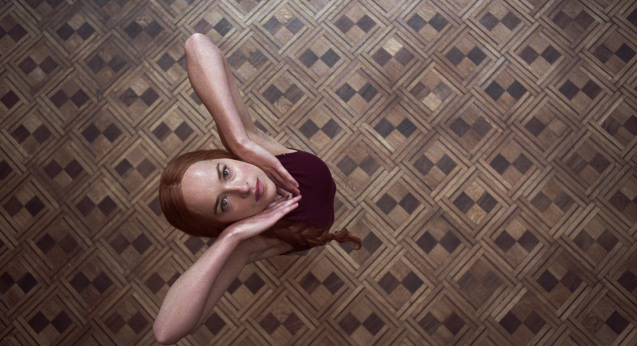Does the new and sensationally horrific Suspiria have style, or merely impersonate it?

I assume anybody unfortunate enough to watch me dance experiences the same feelings as audiences sitting through the new or old Suspiria: abject horror, and an instant dismissal of the very possibility of a higher power or grander purpose. For a long time I considered myself somebody who puts the oogie in the boogie, but director Luca Guadagnino’s remake of Dario Argento’s classic 1977 giallo pic has comforted me with the idea that I might instead be demonically possessed. Perhaps controlled, like a terrible marionette, by another dancer gettin’ telekinetically jiggy wit it.
A moment such as this transpires early in the running time. Protagonist Susie (Dakota Johnson) rehearses at an elite all-female Berlin dance academy, having been encouraged to dance to no music – because feelings. She spins and jabs at the air, busting moves that are sort of beautiful and sort of grotesque, while a telekinetically connected dancer in another location is powerless to prevent her body from bending in all sorts of bone-snapping directions, resulting in her innards spilling all over the place. Susie will discover that the company is run by a coven, which was a twist in the original but revealed at the start of the remake.
In the new Suspiria, Sayombhu Mukdeeprom’s cinematography and Walter Fasano’s editing moves to a similar rhythm as the aforementioned dance, the film itself also sort of beautiful and sort of grotesque. The director (who previously helmed Call Me By Your Name) makes it clear what giallo appreciators would have assumed going into this: that there is only way to remake Argento, and that is boldly. Why anybody would want to remake his work in the first place is another question. The feeling that this is a forbidden fruit sort of ego trip, in the same way the critically obliterated Psycho was an ego trip for Gus van Sant, is exacerbated by the film’s excessive running time, which hits 152 minutes – almost an entire hour longer than the original.
In Guadagnino’s hands that bloated length indicates indulgence rather than lack of discipline, though they are similar things. In slabs of the film when the director’s head disappears up his own arse (as if mimicing that terribly contorted dancer) Suspiria round two becomes a rather galling affair. It’s pretentious as all get out and yet also quite trashy in its extreme violence and genre tropes; a midnight movie to play unironically at art house cinemas. There are many occasions however when the film’s pile-driving atmosphere and horrific ostentation are unquestionably arresting. Guadagnino understands that Argento’s success arose in part from prioritizing patterns over individual pictures; cumulative dread over specific points of impact.
Both versions of Suspiria slowly riddle the senses in a fluid and sticky way, with a rich swirling atmosphere that morphs and evolves – like rapidly ageing poisoned wine. The actors don’t so much hold their own as willfully drown in the sensational sickness of it, although I appreciated Dakota Johnson’s steely charisma – the way she mixes softly-spokenness with bellowing physicality. While rewatching the original left me exhilarated, the remake left me wondering two things. One: whether the film is an impersonation of style or style itself. And two: whether there is any real difference.

















